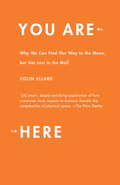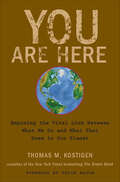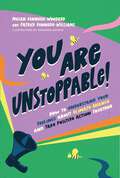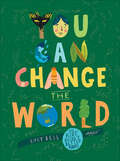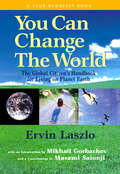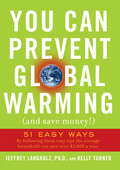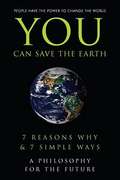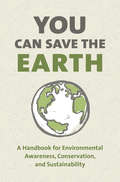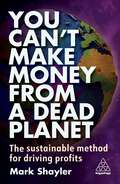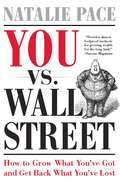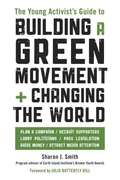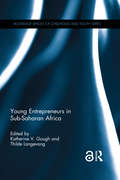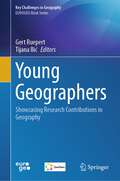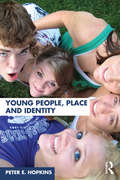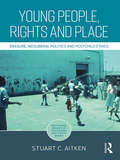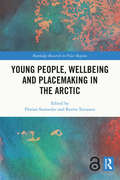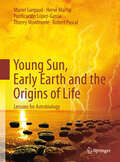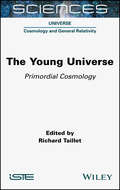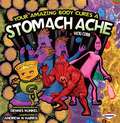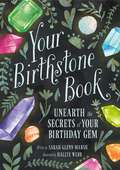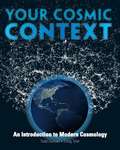- Table View
- List View
You Are Here: Why We can Find Our Way to the Moon but Get Lost in The Mall
by Colin EllardA fascinating exploration of human navigation, both feat and foible, in the age of GPS and GoogleEarth We live in a world crowded by street signs and arrows. With the click of a computer mouse we can find exact directions to just about anywhere on earth, and with a handheld GPS we can find our precise latitude and longitude, even in the remotest of places. But despite all our advancements, we still get lost in the mall, can’t follow directions to a friend’s house and, on camping expeditions, take wrong turns that can mean the difference between life and death. Many other species, however, have an innate sense of direction. Ants display surprisingly sophisticated behavior, traveling great distances without wasting a step. Monarch butterflies and migrating songbirds pilot even greater expanses, thousands of kilometers in some instances, to targets that they might never even have seen before. A homing pigeon can be driven halfway across a continent in a lightproof box and then, on release, find its way—unerringly-back to its loft. What is truly amazing, though, is that humans, the only animal that has come close to understanding how some of these magnificent navigational feats are performed, are rendered helpless by dense bush or even an unexpected turn in a maze of cubicles. InYou Are Here, psychologist Colin Ellard explains how, over centuries of innovation, we have lost our instinctive ability to find our way, as we traverse vast distances in mere hours in luxurious comfort. Some cultures, such as the Inuit, retain the ability to navigate huge expanses of seemingly empty space, as their survival depends on it, but the rest of us have been so conditioned by our built-up world that we don’t really know how to get from point A to point B. Drawing on his exhaustive research, Ellard illuminates this disconnect from our world with great clarity and explains what it means, not just for our forays into the wilderness but for how we construct our cities, our workplaces, and even our homes and virtual worlds. Architects and city planners, he suggests, need to consider human behavior when designing human environments, and we all need to recognize that we are part of, not isolated from, the space around us.
You Are Here: Exposing the Vital Link Between What We Do and What That Does to Our Planet
by Thomas M. KostigenIn this groundbreaking book, the New York Times bestselling coauthor of The Green Book Thomas M. Kostigen reveals the vital missing link in today's environmental crisis: how we as individuals are connected to the most tenuous geography on the planet. Despite the recent prominence of "green" issues in the news, the direct relationship between our actions and the earth is too often ignored. But the seemingly insignificant things we do every day have the power to literally alter the landscape in the ongoing battle to resuscitate the planet.
You Are Unstoppable!: How to Understand Your Feelings about Climate Change and Take Positive Action Together
by Megan Kennedy-Woodard Dr. Patrick Kennedy-WilliamsFeeling sad, scared or angry about climate change? You are not alone. It means that you care. This book helps you harness the power of these emotions and turn them into climate action that will leave you feeling connected, motivated, and powerfully optimistic.You will learn how to:· notice and manage your eco-emotions· become a self-care champion· turn climate anxiety into climate action· inspire others to make changes· and most importantly, enjoy the climate work you do!Your journey starts today. You are unstoppable!"
You Can Change the World: The Kids' Guide to a Better Planet
by Lucy BellYou Can Change the World empowers kids to make changes in their lives and communities with the powerful message that anyone can make a difference in the world. This colorfully illustrated book is packed with information, ideas, and activities for everyday sustainability—like mending clothes, composting, and avoiding single-use plastics. Interspersed throughout are features on children around the globe who are making a difference, such as Greta Thunberg or Solli Raphael, reminding kids that ordinary people can spark extraordinary change.
You Can Change the World: The Global Citizen's Handbook for Living on Planet Earth
by Mikhail Gorbachev Masami Saionji Ervin LaszloYou Can Change the World: The Global Citizen's Handbook for Living on Planet Earth should be required reading for anyone who cares about the future of the planet. Written by renowned scientist, futurist and Club of Budapest founder Ervin Laszlo, You Can Change the World answers two pertinent questions-first, what is at the root of all the conflict and crisis in today's world? And second, what can actually be done to move toward a world where we can live in peace, without marginalizing and killing each other and destroying the environment?A handbook that urges readers to become global citizens who aspire to live responsibly on this precious but highly exploited and crisis-prone planet, You Can Change the World provides a simple and basic message: in today's world it is neither wealth nor power, nor the control of territory and technology that make the crucial difference. How we think and act shapes our present and decides our future.
You Can Change The World
by Ervin LaszloYou Can Change the World: The Global Citizen's Handbook for Living on Planet Earth should be required reading for anyone who cares about the future of the planet. Written by renowned scientist, futurist and Club of Budapest founder Ervin Laszlo, You Can Change the World answers two pertinent questions-first, what is at the root of all the conflict and crisis in today's world? And second, what can actually be done to move toward a world where we can live in peace, without marginalizing and killing each other and destroying the environment?A handbook that urges readers to become global citizens who aspire to live responsibly on this precious but highly exploited and crisis-prone planet, You Can Change the World provides a simple and basic message: in today's world it is neither wealth nor power, nor the control of territory and technology that make the crucial difference. How we think and act shapes our present and decides our future.
You Can Prevent Global Warming (and Save Money!): 51 Easy Ways
by Jeffrey Langholz Kelly TurnerNo-cost and low-cost tips to save thousands of dollars—and reduce carbon emissions that are wreaking havoc on the climate. There’s plenty of public concern about global warming’s effects—mounting natural disasters, mass migrations, crop failures, and more. This new edition of the classic guide shows how to channel that public concern into positive action. It’s filled with simple everyday things you can do to minimize future global warming—and as a bonus, save money at the same time.Whether you’re one of the nearly three-quarters of Americans who consider themselves environmentalists or you’re interested in practical ways to reduce household expenses—or both!—you’ll find hundreds of straightforward tips and suggestions to start putting into practice today.
You Can Prevent Global Warming (and Save Money!): 51 Easy Ways
by Jeffrey Langholz Kelly TurnerNo-cost and low-cost tips to save thousands of dollars—and reduce carbon emissions that are wreaking havoc on the climate. There’s plenty of public concern about global warming’s effects—mounting natural disasters, mass migrations, crop failures, and more. This new edition of the classic guide shows how to channel that public concern into positive action. It’s filled with simple everyday things you can do to minimize future global warming—and as a bonus, save money at the same time.Whether you’re one of the nearly three-quarters of Americans who consider themselves environmentalists or you’re interested in practical ways to reduce household expenses—or both!—you’ll find hundreds of straightforward tips and suggestions to start putting into practice today.
You Can Save The Earth: A Philosophy For The Future
by June EdingWith a fresh, philosophical approach, this work outlines simple and rewarding ways individuals can take action for the good of the Earth--and themselves.
You Can Save the Earth, Revised Edition: A Handbook for Environmental Awareness, Conservation and Sustainability
by Sean K. SmithFinally—a hopeful book which empowers us to make the choices we need to make...not out of fear but out of love for ourselves, our Earth, and each other. In its long-awaited revised edition, You Can Save the Earth, Revised Edition provides even more reasons and ways to pay attention to our planet by being stewards to sustainability. Including the latest information from climate studies, international policy and critical ecological issues, You Can Save the Earth, Revised Edition brings the same level of solution-centered discourse to the next level. Includes inspirational quotes from influential environmentalists and thought leaders including Al Gore, Jacques-Yves Cousteau, Martin Luther King, Jr., Mother Teresa, Walt Whitman, Henry David Thoreau, Howard Zinn, E.F. Schumacher, William Shakespeare, Ayn Rand, and Mahatma Gandhi.You Can Save the Earth, Revised Edition is the perfect book to pick up for your friends, your office, your home, and yourself. While many books on sustainability and climate change focus only on disasters and what has gone wrong–what we have lost–this one takes a new tack. You Can Save the Earth focuses on real-life, simple solutions to many of our global problems, and emphasizes steps that can be taken on an individual basis or on a local level to promote environmental awareness and conservation.A portion of the proceeds from your purchase goes to good, designated for non-profit organizations specifically active in addressing the issues that face the survival of the Earth, including: Wildlife Conservation Society National Audubon Society Save the Whales Sierra Club Waterkeeper AllianceThe Nature Conservancy Cousteau SocietyEarth Corps Go Green InitiativeNational Resources Defense Council People and PlanetThe Mountain Institute The Rainforest Foundation-US
You Can’t Make Money From a Dead Planet: The Sustainable Method for Driving Profits
by Mark ShaylerDoing good is no longer a luxury or a 'nice to have', it's a necessity.While businesses, both big and small, have undoubtedly caused the majority of our environmental and sustainability problems, only they can solve these issues at scale. You Can't Make Money from a Dead Planet looks at the challenges we face and shows how business needs to change in order to be the driver of the solution. Bestselling author and sustainability strategist Mark Shayler explains why there is no contradiction between being profitable and doing the right thing for the planet and doing the right thing for your customers. Providing the insights, the enthusiasm and the tools to align your business with sustainability, it blends explanations of the challenges that we face, with stories from those business that have excelled in sustainability. Exploring current sustainability approaches and trends including net-zero, circular economy, ESG, B-Corps, zero waste and environmental management systems, You Can't Make Money From a Dead Planet explains, debunks and helps you navigate the sustainable agenda while growing your business.
You vs. Wall Street
by Natalie PaceNatalie Pace uses her unique personal story to show readers how they too can win big on Wall Street while staying true to their hearts.
You vs. Wall Street
by Natalie PaceYou vs. Wall Street offers a sensible, easy-to-follow, yet powerful set of investing strategies for any would-be investor--from the complete novice to those with investing experience. You vs. Wall Street is a "must-read financial bible," and "just what some readers need to find themselves exponentially richer in the coming years," according to readers. How does an average investor win on Wall Street? Pace's own story began when she recognized the need for a better plan in 2000, when her Certified Financial Planner tried to sell her mutual funds anchored by the would-be bailouts of that day--Enron, Global Crossing and AOL. Pace averted colossal losses in her own stock portfolio by overweighting safe in 2000. She then developed easy-as-pie chart strategies that utilize the most effective investing strategies available, and learned how to identify which companies are bound for bailouts and which are bound for glory. Pace's trademarked Stock Report CardTM and Four Questions for picking the stars of an industry arm the everyday investor with key data that is available with a few simple clicks on the mouse. Learn how Stocks on Steroids can beautify your Buy My Own Island fund (formerly known as your retirement plan). You vs. Wall Street teaches you how to win on Wall Street in any market--bull or bear. Now is the time to choose wisdom over blind faith, to invest in winning companies and to whistle all the way to your local bailed out bank. * MASTER THE UNIQUE THREE-PART INVESTMENT PLAN * LEARN THE EARNINGS MAGIC OF STOCK REPORT CARDS * DISCOVER THE FOOLPPROOF GET RICH AND STAY RICH PROGRAM * FIND OUT HOW TO AVOID THE TOP ELEVEN INVESTING MISTAKES
The Young Activist's Guide to Building a Green Movement + Changing the World
by Sharon J. SmithIf you want to make a significant and sustainable impact on the health of our planet, this powerful and practical guide can help. Author and activist Sharon J. Smith shares proven strategies and lessons learned from the winners of Earth Island Institute#x19;s Brower Youth Awards-America#x19;s top honor for young green leaders. Here are all the tools you need-from planning a campaign and recruiting supporters to raising money and attracting media attention-to turn your ideas into actions and make changes that matter. All author proceeds from the sale of this book go to Earth Island Institute#x19;s Brower Youth Awards to support the next generation of young activists.
Young Children and the Environment
by Julie M. DavisYoung Children and the Environment tackles one of the biggest contemporary issues of our times - the changing environment - and demonstrates how early education can contribute to sustainable living. An essential text for students in early childhood education and a practical resource for child care practitioners and primary school teachers, it is designed to promote education for sustainability from birth to 8 years. The text refers to national and international initiatives such as 'Sustainable Schools', 'Child Friendly Cities', and 'Health Promoting Schools' and explores their existing and potential links with early childhood education. Groundbreaking content draws on recent literature in the areas of organisational, educational and cultural change and environmental sustainability. Early childhood case studies and vignettes exemplify leadership in practice, and 'Provocations' are integrated throughout to inspire new ways of thinking about the environment, the wider world, young children and the transformative power of early education.
Young Entrepreneurs in Sub-Saharan Africa (Routledge Spaces of Childhood and Youth Series)
by Katherine V. Gough Thilde LangevangYoung people in sub-Saharan Africa are growing up in rapidly changing social and economic environments which produce high levels of un- and underemployment. Job creation through entrepreneurship is currently being promoted by international organizations, governments and NGOs as a key solution, despite there being a dearth of knowledge about youth entrepreneurship in an African context. This book makes an important contribution by exploring the nature of youth entrepreneurship in Ghana, Uganda and Zambia. It provides new insights into conceptual and methodological discussions of youth entrepreneurship as well as presenting original empirical data. Drawing on quantitative and qualitative research, conducted under the auspices of a collaborative, interdisciplinary and comparative research project, it highlights the opportunities and challenges young people face in setting up and running businesses. Divided into a number of clear sections, each with its own introduction and conclusion, the book considers the nature of youth entrepreneurship at the national level, in both urban and rural areas, in specific sectors - including mobile telephony, mining, handicrafts and tourism - and analyses how key factors, such as microfinance, social capital and entrepreneurship education, affect youth entrepreneurship. New light is shed on the multi-faceted nature of youth entrepreneurship and a convincing case is presented for a more nuanced understanding of the term entrepreneurship and the situation faced by many African youth today. This book will be of interest to a wide range of scholars interested in youth entrepreneurship, including in development studies, business studies, youth studies and geography, as well as to development practitioners and policy makers. The Open Access title has now been added to the Open Access page. http://www.tandfebooks.com/page/openaccess
Young Geographers: Showcasing Research Contributions in Geography (Key Challenges in Geography)
by Gert Ruepert Tijana IlićThis book shows an updated overview of research about human geography topics like urban growth/urban challenges, transportation, landscape, land cover, geospatial analysis, regional planning/local development, cultural geography, tourism, and so on. Between 2020 and 2022, due to COVID-19 and lockdowns worldwide, there were fewer opportunities for young and upcoming researchers to present their state-of-the-art findings at conferences. In order to highlight exceptional research of young geographers during this time, the idea for this book was created. In collaboration with the EGEA alumni foundation for students and young geographers, 12 authors were selected to showcase their scientific work. In addition to that, most of them present amazing maps and figures as outstanding expression of the need of GIS for geography research.
Young People, Place and Identity
by Peter E. HopkinsYoung People, Place and Identity offers a series of rich insights into young people’s everyday lives. What places do young people engage with on a daily basis? How do they use these places? How do their identities influence these contexts? By working through common-sense understandings of young people’s behaviours and the places they occupy, the author seeks to answer these and other questions. In doing so the book challenges and re-shapes understandings of young people’s relationships with different places and identities. The textbook is one of the first books to map out the scales, themes and sites engaged with by young people on a daily basis as they construct their multiple identities. The scales explored here include the body, neighbourhood and community, mobilities and transitions and urban-rural settings and how these all shape and are shaped by young people’s identities. Each chapter explores how social identities (such as race, gender, sexuality, class, disability and religion) are constructed within particular contexts and influenced by multiple processes of inclusion and exclusion. These discussions are supported by details of the research methods and ethical issues involved in researching young people’s lives. Drawing upon research from a range of contexts, including Europe, North America and Australasia, this book demonstrates the complex ways in which young people creatively shape, contest and resist their engagements with different places and identities. The range of issues, topics and case studies explored include: ethical and methodological issues in youth research; youth subcultures; experiences of home; territorialism; youth and crime; political engagement and participation; responses to global issues; engagements with different institutional contexts; negotiating public space; the transition to adulthood; drinking cultures. The author explores these issues through blending together original empirical research, theory and policy. Individual chapters are supported by key themes, project ideas and suggested further reading. Details of key authors, journals and research centres and organisations are also included at the end of the book. This textbook will be pertinent for undergraduate and postgraduate students and academic researchers interested in better understanding the relationships between young people, places and identities.
Young People, Rights and Place: Erasure, Neoliberal Politics and Postchild Ethics (Routledge Spaces of Childhood and Youth Series)
by Stuart C. AitkenConcern is growing about children’s rights and the curtailment of those rights through the excesses of neoliberal governance. This book discusses children’s spatial and citizenship rights, and the ways young people and their families push against diminished rights. Armed initially with theoretical concerns about the construction of children through the political status quo and the ways youth rights are spatially segregated, the book begins with a disarmingly simple supposition: Young people have the right to make and remake their spaces and, as a consequence, themselves. This book de-centers monadic ideas of children in favor of a post-humanist perspective, which embraces the radical relationality of children as more-than-children/more-than-human. Its empirical focus begins with the struggles of Slovenian Izbrisani (‘erased’) youth from 1992 to the present day and reaches out to child rights and youth activists elsewhere in the world with examples from South America, Eastern Europe and the USA. The author argues that universal child rights have not worked and pushes for a more radical, sustainable ethics, which dares to admit that children’s humanity is something more than we, as adults, can imagine. Chapters in this groundbreaking contribution will be of interest to students, researchers and practitioners in the social sciences, humanities and public policy.
Young People, Wellbeing and Sustainable Arctic Communities (Routledge Research in Polar Regions)
by Stammler Florian Toivanen ReettaYouth are usually not (yet) decision makers in politics or in business corporations, but the sustainability of Arctic settlements depends on whether or not youth envision such places as offering opportunities for a good future. This is the first multidisciplinary volume presenting original research on Arctic youth. This edited book presents the results of two research projects on youth wellbeing and senses of place in the Arctic region. The contributions are united by their focus on agency. Rather than seeing youth as vulnerable and possible victims of decisions by others, they illustrate the diverse avenues that youth pursue to achieve a good life in the Arctic. The contributions also show which social, economic, political and legal conditions provide the best frame for youth agency in Arctic settlements. Rather than portraying the Arctic as a resource frontier, a hotspot for climate change and a place where biodiversity and traditional Indigenous cultures are under threat, the book introduces the Arctic as a place for opportunities, the realization of life trajectories and young people’s images of home. Rooted in anthropology, the chapters also feature contributions from the fields of sociology, geography, sustainability science, legal studies and political science. This book is intended for an audience interested in anthropology, political science, Arctic urban studies, youth studies, Arctic social sciences and humanities in general. It would attract those working on Arctic sustainability, wellbeing in the Arctic, Arctic demography and overall wellbeing of youth.
Young Sun, Early Earth and the Origins of Life
by Hervé Martin Muriel Gargaud Purificación López-García Robert Pascal Storm Dunlop Thierry Montmerle- How did the Sun come into existence? - How was the Earth formed? - How long has Earth been the way it is now, with its combination of oceans and continents? - How do you define "life"? - How did the first life forms emerge? - What conditions made it possible for living things to evolve? All these questions are answered in this colourful textbook addressing undergraduate students in "Origins of Life" courses and the scientifically interested public. The authors take the reader on an amazing voyage through time, beginning five thousand million years ago in a cloud of interstellar dust and ending five hundred million years ago, when the living world that we see today was finally formed. A chapter on exoplanets provides an overview of the search for planets outside the solar system, especially for habitable ones. The appendix closes the book with a glossary, a bibliography of further readings and a summary of the Origins of the Earth and life in fourteen boxes.
The Young Universe: Primordial Cosmology
by Richard TailletThe Young Universe presents four major physical and astrophysical themes related to these extreme phases of the primordial universe. In particular, it presents the physics of the primordial plasma and the concepts of quantum and particle physics necessary to describe this extreme state.It discusses the cosmological background radiation and explores inflation, an extremely rapid expansion phase that is believed to have occurred very early in cosmological history and to have shaped our present universe. The book also provides a synthesis of the dark matter problem.
Your Amazing Body Cures a Stomach Ache
by Vicki CobbMeet your personal superheroes - your body's cells! Superhero cells rally together to battle common childhood ailments in this series in which Vicki Cobb explains how your amazing human body heals itself and fights off intruders.
Your Birthstone Book: Unearth the Secrets of Your Birthday Gem
by Sarah Glenn MarshLearn the amazing (and sometimes magical) history of gemstones from around the world through the corresponding birthstones that represent each month of the year.Gemstones are among Earth&’s rarest and most beautiful creations. They are history&’s preeminent symbols of wealth and power. They are valued because they are beautiful and rare, but also because their beauty is undiminished with time. The stone that once adorned a king or maharaja, might today be set in a ring or necklace, and if not destroyed, will continue to sparkle thousands of years from now. This history only increases the value of these stones.What better way to teach young readers about gemstones than by focusing on the different birthstones that correspond to each month of the year? Everyone (mostly) knows their birthstone. But do they know the full history of these stones--where they were mined, how/why they were popular, or how to best harness a stone's energy to help deal with matters of friendship, family, and life? Your Birthstone Book will give readers insight into the powers assigned different bithstones while exploring their fascinating uses over the course of history.
Your Cosmic Context: An Introduction to Modern Cosmology
by Todd Duncan Craig TylerYour Cosmic Context provides a framework for exploring the nature and history of our universe. Equally well suited for independent reading and study or for a one-term general education course in cosmology, this book is a guide to the key insights of scientific cosmology, including the big bang theory and exotic entities like dark matter and dark energy. It also explains how we discovered the surprising things we now know about the distant reaches of space and time, and thereby serves as one of the best available illustrations of the scientific method in action.
